Lenses and Looking-Glasses
Some experiments with transparent spheres, cylinders, and other curved shapes.
What do you see when you gaze into a crystal ball? If you could make a perfectly clear sphere of glass (or water), and look into it, what would it show you? Crystal balls have a mythical power to magically show you other places or other times, like a primitive television set, and I assume that these myths evolved from the fact that you can actually see some remarkable things when you look into or through a real transparent sphere. Sometimes you don't see anything but blurry colors. But if you hold it and look through it in the right way, you can see some amazing things. Among other things, you can use it as a magnifier. A transparent sphere can make things look larger than they really are, and can give you a much better look at ants and flies and other tiny things.
The magnifying ability of glass or water spheres has been known for a thousand years, perhaps two. But studying the powers, learning how they work, and refining these powers into useful optical devices — these things have only happened in the last few hundred years. Let's see if we can make (or buy) our own simple optical devices, and learn how their powers work as we play around with them.
Optical Spheres
To demonstrate the powers of “crystal balls” or transparent spheres, I wanted some decent-sized glass globes, so that I could have my students look through them. I put a fair bit of effort into trying to locate appropriate crystal balls. To my disappointment, all of the commercial “crystal balls” that I found were unusable. They either had markings or decorations of some kind, or were coated with some kind of hazy gloss, or were much too expensive. I just wanted a clear glass sphere, and I couldn't find any. But I did eventually find a couple of simple, cheap, and effective substitutes.
One day while wandering through the craft store, I discovered that they sell empty snow globes, for people who want to make their own. Normally, you buy the hollow plastic globe, a snowman or something to put inside, and some artificial “snow.” Then you assemble the pieces, fill the globe with water, shake it, and watch the snow settle. But if you buy just the globe and fill it with nothing but clean water, then you have your very own crystal ball.

(Assembly tip: If you fill the globe by pouring water into it from a faucet or a pitcher, you may find it difficult to avoid trapping air bubbles inside. You can make the globe bubble-free by submerging it in a sink or bucket and assembling it underwater.)
Another solution I discovered is decorative marbles. I originally gave up on marbles, because I was looking for them in toy stores, and all of the toy-store marbles were cloudy or colored or had decorations of some kind. Even the “plain” ones often had a hazy sheen that made them unusable as transparent spheres. But then I discovered that craft stores sell small, plain, clear marbles in large quantities for filling vases and other decorative purposes. These make wonderful classroom crystal balls because you can buy large numbers of them cheaply, and then every student can take one home (if they can keep from losing them before the end of the day.) The only flaw is that these marbles often contain tiny air bubbles, but those are usually not a problem. The marbles are also pretty small, but the kids don't seem to mind that too much. (In fact, the smaller the sphere, the more it magnifies, and marble-magnifiers can be a great introduction to “Leeuwenhoek microscopes.”)
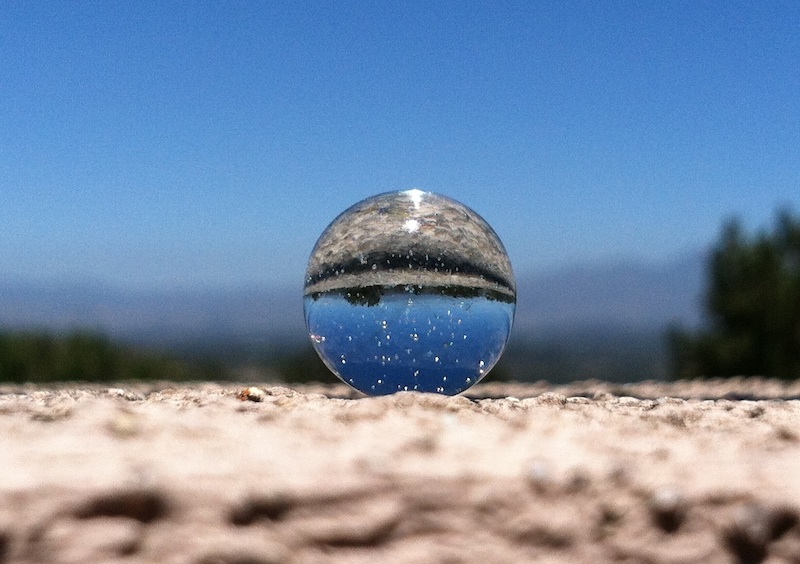
Another suggestion that I have come across is to bend the end of a paperclip into a loop, and try to capture a tiny droplet of water. This might be fun for students to try, but in my experience it only really works for extremely tiny droplets — too small to be useful in an elementary classroom.
So, to come back to my original question, what do you see if you look through a transparent sphere, or a crystal ball? The first thing students usually notice is that everything is upside down. You can see this clearly in the pictures above. I also like to point out that everything has shrunk. If you were to look through a plain flat disk of the same size (in other words, a round glass window) you would just see a disk-sized slice of the world on the other side. But the sphere has taken the entire scene on the other side, from one horizon to the other, and squashed it into the face of the sphere. In a sense, you can see the whole world in a crystal ball.
If you place the crystal ball up close to something, you will also notice something else that the sphere can do — it can magnify things. This only works for things that are very close to the other side of the sphere, but it can give you a much better look at tiny things that otherwise would be hard to see. The following two pictures show my attempts to photograph spheres magnifying text and the markings on a ruler. Perhaps you could use yours to study insects, or sand, or food, or the fibers in a cloth or a piece of paper.
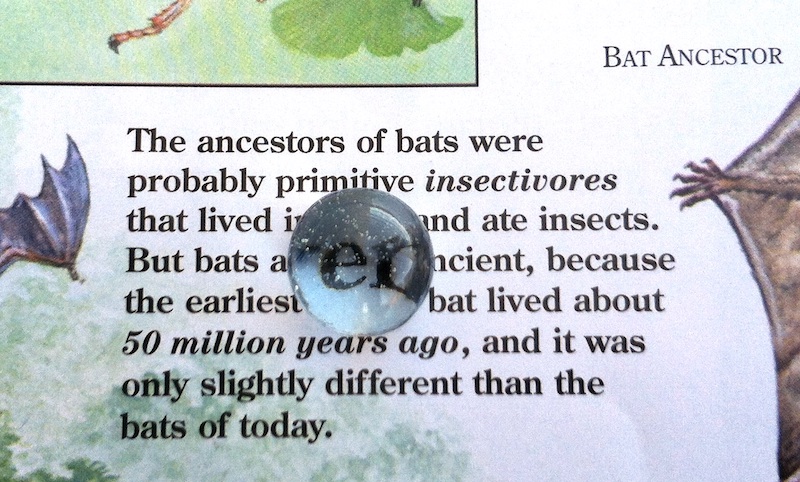
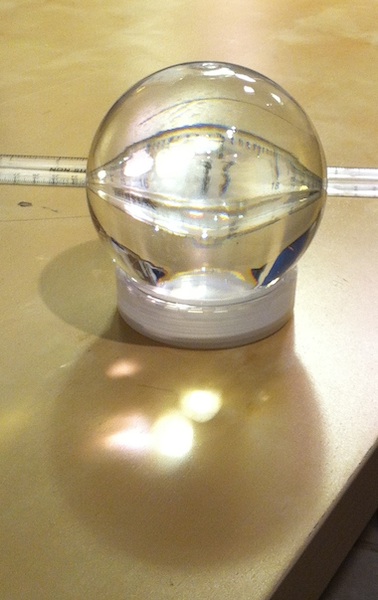
As you play around with transparent globes, especially when you bring them close to surfaces in order to magnify them, you may also notice another interesting ability of crystal balls. In the second photo above, you may notice images of the lights in the background appearing on the desktop. The globe has made a picture of the lights appear on the surface of the desk … although they aren't that clear. Could we make them clearer? Do you suppose we can make pictures of other things besides lights appear? The desk in the picture above is horizontal, and also has some colors in it. To catch the “picture”, let's use a plain piece of white paper or some other kinds of blank “screen”, and let's hold it vertically so it can catch the image better. (Actually, it is best to hold it perpendicular to whichever way you are “facing” your globe. So if you are trying to make pictures of overhead lights, lay the paper flat underneath the globe.) Now, try holding up your globe and your “screen” in a dark room with a bright scene of some kind on the other side of the room — a window or a TV or an aquarium or some other bright lighted scene. The picture below shows a globe projecting a picture of a window onto the nearby wall. You'll notice the reflection of the window on the front of the globe, and the projection of the window's image onto the wall behind the globe, inside the globe's shadow.
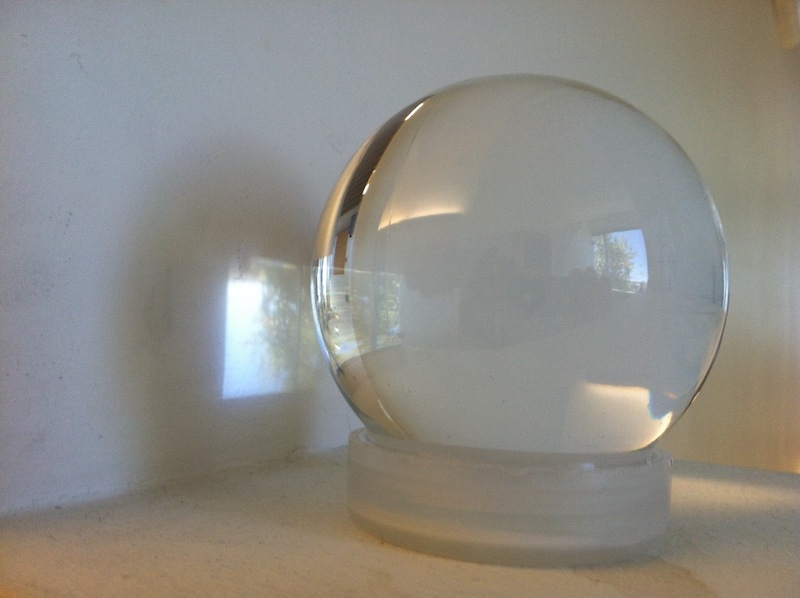
So here is another ability of transparent spheres: they can be image projectors. You can use them to cast pictures of bright scenes onto screens.
Let's summarize all of the interesting powers of crystal balls that we have noticed. Or to put it in more scientific words, let's list some optical properties of transparent spheres:
- They make far away things appear small and upside-down.
- They very close things look bigger. (They "magnify.")
- They can cast images of bright scenes.
Optical Cylinders
Transparent cylinders are even easier to make than transparent spheres. Just find a smooth-walled jar, bottle, or glass, and fill it with water. Since we have just discovered some abilities of transparent spheres, why don't we see if cylinders can do the same things? For this, a standard 2-liter soda bottle with the label removed works well. There will be a little glue residue left on the plastic after you remove the label, but you can work around this. Glass jars also work well, if you can find one with plain smooth walls. (I find that glass jars aren't quite as “pretty” or remarkable as water-filled plastic bottles. The jar manufacturers aren't aren't expecting you to use it like a lens and aren't very concerned about the optical quality of their jars. So there are often tiny imperfections and subtle wrinkles that make images slightly “warped” or “blurry” when you look through them, or try to use them to cast images. Decorative cylindrical vases work a little better than glass bottles and jars in this regard.)
What happens if you look through a cylinder at a far-away scene? What happens if you hold something close to the other side of your cylinder? Will it magnify the object? And what about projecting images? Can cylinders to that, too? I'll show you a couple of pictures that I took looking through water-filled jars, and you can explore the other questions on your own. In the first picture below, the jars are very close to a pair of colored squares. (All pairs of squares are identical on the paper, or as identical as I could make them.) Notice that the cylinders stretch or magnify the image, like spheres do, but only in one direction, the direction of the curve of the jar. In the second picture below, the jars are somewhat farther away. Notice that they flip the images, like spheres do, but only in the direction of the curve. The important thing in all of this seems to be the curved face. The cylinder is only curved sideways, so it is only affecting the image in a sideways way. If you pay close attention to the images in spheres, you'll notice that they are not only upside-down but also reversed from left to right. Spheres are curved in both directions, and they flip the image in both directions. The cylinders are only curved in one direction, and they only flip the image in one direction.
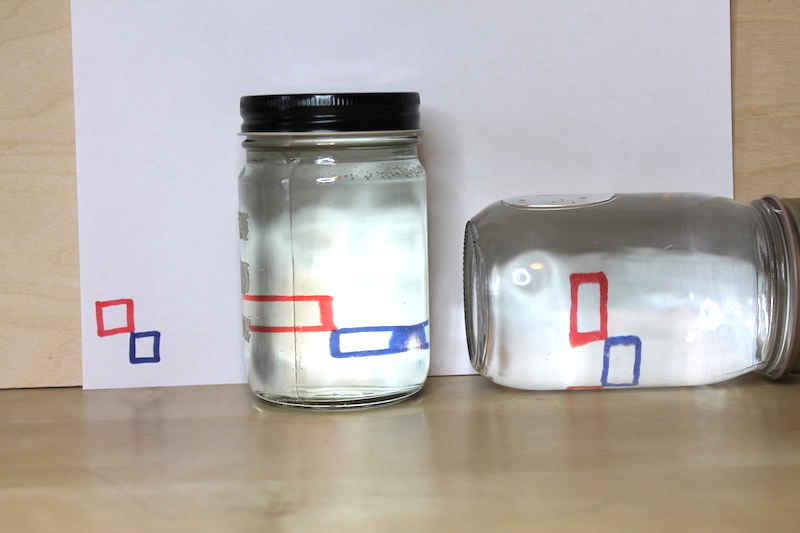

So if we wanted to summarize the powers of water-cylinders, or more precisely the optical properties of transparent cylinders, we could say that they have all the same abilities as spheres, except that they only flip or magnify the image in the direction of the curve. In the direction parallel to the axis of the cylinder, the image is unaffected.
Improving a Sphere
The power of spheres to give you a better look at small things is a wonderful ability. But the image you see in the globe isn't worth much around the edges. When you look through the crystal ball, only the middle part of the image is clear, while the picture near the sides of the globe is stretched and warped and not very helpful. The globe is also very bulky and not very convenient, and you have to hold things right up next to the globe to get a better look at them. Is there a way we can improve the sphere, and make it a better magnifier? Can we take the crude magnifying ability of the transparent sphere, and refine it into a more useful optical device?
Reading Stones
One simple device that has been around for about a thousand years is the “reading stone”, which is essentially a transparent sphere cut in half. It has a flat side and a rounded side. You rest the flat side against the paper, look through the curved top, and slide it around as you read. You can often find acrylic versions of these things in modern book stores. Sometimes they make half-cylindrical versions so you can read an entire line at a time. And not only do these “reading stones” magnify the text, they also have a remarkable ability to gather ambient light and concentrate it on the page under the stone. (Although sometimes it is brighter inside the stone, and sometimes it is darker. If you experiment with lights in different places, maybe you can discover what makes the difference.)
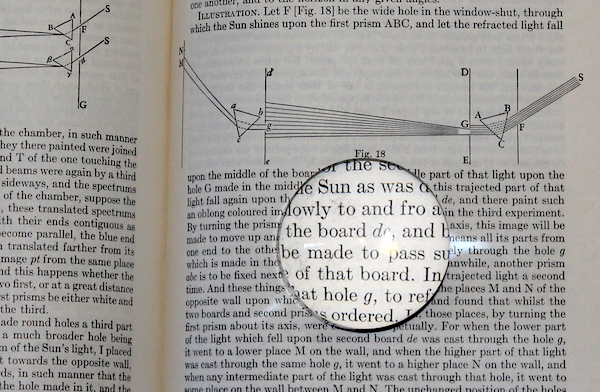
Lentils
Cutting the sphere in half helps to make it a little more useful. What about cutting it into even smaller pieces? But which parts of the sphere should we save and which parts can we throw away?
The power of the sphere seems to lie in the curved faces. When you look through a sphere, there is a “front” and a “back” that you are looking through, like the two faces of a glass window, and there are the “sides” around the edges that don't help at all. What if we got rid of the middle of the sphere, and we kept only the front and back faces?

If you have ever played with a magnifying glass, you have probably noticed that it has this shape. It is thick in the middle and thinner at the edges, with smooth curved faces on the front and back. A magnifying glass is very much like a crystal ball with most of the useless glass middle thrown away.

This optical device is much thinner, lighter, and more convenient than the sphere that it came from, but does it have all the same abilities? If you run through the list of abilities that we made above, can you discover if the magnifying glass has all of the same powers as spheres? Is is better or worse than the sphere at doing these things?
By the way, what should we call this new shape? We have names for “sphere” and “hemisphere” and “cylinder.” What about this magnifying-glass shape? If you cook or eat lots of legumes, you will probably be familiar with lentils, and lentil seeds have exactly this shape. They have two rounded sides, and they are thick in the middle and thin at the edges. So any time we find something with this shape, we can say that it is “lentil-like” or “lenticular.” For short, we can call this shape a “lens.” You may have heard magnifying glasses called magnifying lenses, and the name “lens” comes from the lentil-shape that it must have in order to work properly.
Flat Lenses
The lens is much flatter and more convenient that the sphere, but it would be even better if it were completely flat. Then we could carry a small card-sized magnifier in a billfold, or we could keep a large one on a shelf or in a filing cabinet with other flat things. Flat things are much easier to store than round things. But isn't the curve important? Don't the interesting powers of spheres, cylinders, and lenses come from the curved faces? If we make a piece of glass with flat sides, we just have a window. So how could it be possible to make a flat magnifier? How is it possible to make a flat curved thing?
The lens is much “flatter” and more convenient that the original sphere, and we got there by throwing away the glass in the middle, because it wasn't doing anything. Maybe we can throw away more of the useless class in the middle? Can we throw away enough glass to make the lens completely flat? What if we made a piece of glass with this shape:

Perhaps you've seen “card magnifiers” in stores. (I used to be able to find magnifying cards in hobby stores and fabric stores, alongside “normal” magnifying glasses. They were often sold with the patterns and stencils for fabric work. But now I'm having trouble finding them. I'm not sure they're sold in stores much anymore, but you can still find many of them on Amazon. Also, they are normally made of plastic rather than glass. Making a glass object with this shape is too difficult. ) If you run your fingernail across the surface of such a flat magnifier, you'll discover that it is full of tiny ridges and grooves. These are the remnants of the curved surface, and it is that shattered curved surface which is providing the magnification.
(In my illustration above, I sliced the original lens into equally-spaced slices, and you'll notice that this results in the sides being rather “pointy” and taller than the middle, which is lower and smoother. In practice, as I understand it, manufacturers normally make the slices unevenly spaced, so that there are more finer grooves near the edges, and fewer wider grooves near the center.)
Notice that each “ridge” of the lens is a little like a triangular prism, and the entire lens is a little like an array of many circular prisms. In fact, this is how such “flat lenses” originally came to be. In the early 19th century, Augustin-Jean Fresnel invented an arrangement of large circular prisms that worked like a gigantic lens, for projecting brilliant warning beams of light from lighthouses, without having to use several tons of glass to make a normal lens shape. To this day, all of these “flattened” or “broken up” lenses are called Fresnel Lenses. If you ever find any lighthouse lenses in a museum (or a lighthouse), stop and admire them for a while, because they are gorgeous, almost like giant mathematical glass chandeliers.
Fresnel lenses are not used much when we want a sharp, clear image, because all the ridges and grooves make the image not very clear. The ridges and grooves don't bother us much in casual pocket magnifiers, but in telescopes, we always use pure glass lenses with exact shapes. However Fresnel lenses are wonderful when you just care about gathering (or projecting) huge amounts of light. They make wonderful solar collectors for burning things with sunlight.